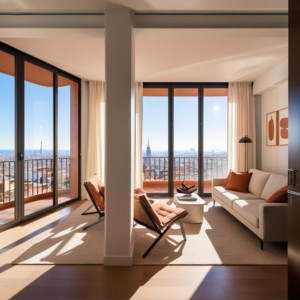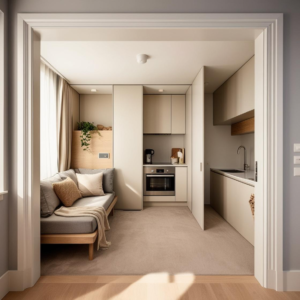The 5 Types of Housing in Spain to Discover in 2024: Find Your Property
Spain is a destination of choice for property investors, expatriates and those looking to relocate to a sunny European country. In 2024, the Spanish real estate market continues to attract a large number of buyers, thanks to its varied landscapes, pleasant climate and dynamic cities. However, before making a purchase, it’s essential to know about the 13 main types of housing in Spain. Each type has unique characteristics, as well as specific advantages and disadvantages that may influence your decision.
Whether you’re looking for a cozy apartment in Barcelona, a villa in Marbella, or a country cottage in the mountains, this article offers a comprehensive guide to the different types of property you can find in Spain, their prices and where to look for them. We’ll also add internal links to direct you to additional resources, as well as external links to help you find real estate agents, platforms and services related to property buying.
1. Apartamento (Apartment)
The apartment in Spain, or apartamento, is probably the most common type of accommodation, especially in large cities. It can be a small studio, a one-bedroom apartment, or even a larger family apartment. Apartments are often chosen by those who prefer city life, with all its advantages: nearby amenities, easy access to public transport and a wide range of activities.
Advantages :
– Proximity to amenities: These apartments are often located in the heart of cities, within walking distance of stores, restaurants, bars and public transport. Perfect for those who like to be in the center of the action.
– Low maintenance: Compared to a house, an apartment is easier to maintain because it has no garden and often less outdoor space to manage.
Disadvantages :
– Less privacy: Living in a block of flats means you’ll be surrounded by neighbors, which can lead to noise pollution and less privacy.
– No garden or terrace: Although some apartments have small balconies, private gardens are rare and often reserved for houses.
Guide price :
– 100,000 to €500, 000 depending on location (Madrid, Barcelona, Valencia, etc.).
Additional tip:
If you’re thinking of buying an apartamento, consider the layout of the building. An apartment on a high floor with a nice view may cost more, but it will also offer more privacy and less noise. Don’t forget to check renovation regulations and condominium fees. A condominium with amenities such as a swimming pool or gym may have high additional charges.
Useful external links :
– Inmo Gusto to explore apartments all over Spain.
2. Piso (Penthouse)

The piso is a slightly larger form of apartment, usually located in a building that houses several other dwellings. Unlike an apartamento, which can be smaller and more compact, a piso is often more spacious and can offer several bedrooms, making it an excellent choice for families.
Advantages:
– More living space: With several bedrooms and large living rooms, the piso is ideal for a family or for those looking for more comfort without wanting to manage a large garden.
– Good rental investment: If you plan to rent the property, a piso located in a central area is often more attractive to tenants.
Disadvantages:
– Extra maintenance: Pisos may require more maintenance than smaller apartments, especially if they have several extra rooms and equipment such as built-in wardrobes or modern kitchens.
– Cost of charges: Condominium fees may be higher, especially in modern buildings with shared facilities (elevator, security, green spaces).
Guide price :
– €250,000 to €1 million, depending on location, size and quality of construction.
Additional tip:
If you’re buying a piso, be sure to check the structure of the building. Older buildings may have plumbing or electrical problems. An expert assessment can save you a lot on future repairs. Evaluate the piso’s location in relation to public transport, schools and shops. This will largely determine the profitability of your investment if you decide to rent it out.
– Inmo Gusto to explore apartments all over Spain.
3. Chalet (Villa)
Chalets are detached houses that usually offer a large garden, sometimes a swimming pool, and a quieter environment than city apartments. This type of property is often located on the outskirts of large towns or in rural areas, making them ideal for those looking to get away from the hustle and bustle of the city.
Advantages:
– Large outdoor space: A chalet is often surrounded by a vast garden, sometimes with a swimming pool, perfect for families, pets, or even for those who wish to have their own vegetable garden.
– Tranquility and privacy: With a chalet, you generally enjoy great privacy, away from the noise and density of urban areas.
Disadvantages:
– High maintenance: Managing a large garden and property can be costly in terms of time and money. In addition, maintenance of the pool, facades, etc., can add to the monthly costs.
– High purchase cost: Chalets, especially those in popular locations such as Marbella, the Costa Brava or the Balearics, can be very expensive.
Guide price :
– €300,000 to €5 million, depending on size and location.
Additional tip:
Before buying a cottage, make sure it has good thermal and sound insulation. Homes in rural areas can sometimes be exposed to greater temperature variations. If you choose a property in a more isolated area, check access to essential services such as schools, hospitals and supermarkets. This can make life more convenient in the long run.
– Inmo Gusto to explore apartments all over Spain.
4. Casa Adosada (Semi-detached house)
Casas adosadas are semi-detached houses, often located in residential areas. This type of property is generally found in suburban areas, offering an intermediate solution between the urban apartment and the single-family home in a quieter setting.
Advantages:
– Secure community: Many of the residential neighborhoods where casas adosadas are located are gated and secure, offering a safe environment for families.
– Good value for money: Cheaper than a chalet yet offering plenty of living space, these homes often come with small courtyards or gardens.
Disadvantages:
– Less privacy: As terraced houses, casas adosadas share walls with neighbors, which can be a nuisance if noise is an issue.
– Limited outdoor space: Although the house has a small garden, it’s often not as large as that of a villa or chalet.
Guide price :
– €150,000 to €500,000, depending on size, location and equipment.
Additional advice:
If you’re considering buying a casa adosada, check condominium costs, as some neighborhoods with common areas (pools, gardens, etc.) can have high monthly fees. Think ahead: a developing neighborhood may offer good potential for capital appreciation, but it may also present nuisances such as construction sites or ongoing construction.
– Inmo Gusto to explore apartments all over Spain.
5. Finca (Farmhouse or country house)
Fincas are rural properties, often very spacious and with large areas of land. They are ideal for those looking to escape city life, offering a natural, secluded setting.
Advantages:
– Vast spaces and land: Fincas are perfect for those wishing to farm, raise livestock or carry out personal projects such as creating a large garden or farmhouse.
– Peaceful setting: Fincas offer a tranquility not found in cities, often with spectacular views of the countryside or mountains.
Disadvantages :
– Isolation: One of the major disadvantages of a finca is its remoteness. It can be difficult to access essential shops or services without a car.
– High maintenance costs: Running a finca requires a constant investment of time and money to maintain the property, the land and sometimes the farm facilities.
Guide price :
– €150,000 to €2 million, depending on size and location.
Additional advice:
If you’re interested in buying a finca, it’s essential to check access to water and electricity, as some rural properties may be poorly served in terms of infrastructure. Also, assess the cost of renovation if there are buildings or infrastructure to restore.
– Inmo Gusto to explore apartments all over Spain.
Conclusion
Spain offers a wide range of real estate options, to suit all types of buyer, from urban apartments to seaside cottages to isolated rural houses. Choosing the right type of accommodation depends on your priorities: whether you’re looking for urban convenience, space and privacy, or peace and quiet in the countryside.
Before making your decision, don’t forget to consider practical aspects such as maintenance costs, proximity to essential services and transport accessibility. Using a specialized real estate agent can also help you navigate the specifics of the Spanish market and find the property that suits you best.







